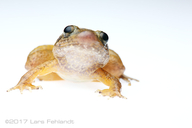|
Limnonectes hikidai Matsui & Nishikawa, 2014
| family: Dicroglossidae subfamily: Dicroglossinae genus: Limnonectes |
| Species Description: Matsui M, Nishikawa K 2014 Description of a new species of Limnonectes from Sarawak, Malaysian Borneo (Dicroglossidae, Anura). Curr Herpetol 33: 135-147. | |
 © 2019 Lars Fehlandt (1 of 3) |
|
|
|
Description DIAGNOSIS: This species can be distinguished from Limnonectes khasianus by having less webbing on the 4th toe (3 free phalanges vs 2), having a rough dorsum with wrinkles radiating from small warts vs a smooth dorsum, and in males, by having a sharply pointed tusk (Matsui and Nishikawa 2014). For more diagnosis please see Matsui and Nishikawa 2014. COLORATION: In preservative, the dorsum is brown with dark brown patterning. There is a dark bar between the eyes, as well as a dark temporal stripe spanning along the supratympanic fold behind the eye. The upper lip has dark brown bars, while the lower lip is dark brown with light spots. The throat is a mottled brown, while the rest of the venter is beige with some brown spotting. The limbs have dark dorsal banding and light brown ventral mottling. The hands and feet are dark brown both dorsally and ventrally. In life, the venter of the hind limbs and posterior section of the abdomen has a yellow hue (Matsui and Nishikawa 2014). VARIATION: While females are typically slightly larger than males, they are not statistically different and there is no other form of sexual dimorphism. Some individuals have a light beige mid-dorsal stripe. Most individuals have dark mottling on the throat and ventral sides of the hindlimbs, though the degree of the mottling is varied (Matsui and Nishikawa 2014). Distribution and Habitat Country distribution from AmphibiaWeb's database: Malaysia Malaysian region distribution from AmphibiaWeb's database: Sarawak
Life History, Abundance, Activity, and Special Behaviors This species spends its time in shallow water ranging from >1 - 4 cm in depth (Matsui and Nishikawa 2014). During the breeding season, which lasts from August to December, males call from the shallows. Males produce single or double note calls, with the first note lasting between 87 - 148 milliseconds, and the second note lasting between 60 - 81 milliseconds. The calls are composed of multiple pulsating frequencies, with the dominant frequencies being between 2.98 - 4.10 kHz and 3.34 - 3.51 kHz, respectively (Matsui and Nishikawa 2014). Gravid females can be found from September to November. Females produce a clutch of 20 - 45 eggs. Ova range from 2.4 - 2.8 mm and have a black animal pole (Matsui and Nishikawa 2014). Larval development is currently unknown (Matsui and Nishikawa 2014). Limnonectes hikidai can be found in sympatry with Ansonia leptopus, Limnonectes palavaenesis and what is assumed to be Leptobrachium montanum, and Limnonectes kuhlii (Matsui and Nishikawa 2014). Larva Trends and Threats Possible reasons for amphibian decline General habitat alteration and loss Comments PHYLOGENETIC RELATIONSHIPS: Maximum Likelihood analysis of mitochondrial rRNA genes 12S and 16S show that L. hikidai is sister to the clade formed by L. khasianus, L. kuhlii, L. macrognathus, and L. tweediei (Matsui and Nishikawa 2014). Matsui and Nishikawa (2014) split L. hikidai, found on Borneo, from L. khasianus from continental Thailand. Prior to this split, L. lapticeps was also downgraded to be part of L. khasianus. ETYMOLOGY: This species was named after Dr. Tsutomu Hikida, a professor at Kyoto University who was instrumental in starting herpetological surveys in Sarawak (Matsui and Nishikawa 2014).
References
Matsui, M., Nishikawa, K. (2014) “Description of a new species of Limnonectes from Sarawak, Malaysian Borneo (Dicroglossidae, Anura)”. Current Herpetology, 33(2), 135-147. Originally submitted by: Elaine Wittry (2022-10-11) Description by: Elaine Wittry (updated 2022-10-11)
Distribution by: Elaine Wittry (updated 2022-10-11)
Life history by: Elaine Wittry (updated 2022-10-11)
Larva by: Elaine Wittry (updated 2022-10-11)
Trends and threats by: Elaine Wittry (updated 2022-10-11)
Comments by: Elaine Wittry (updated 2022-10-11)
Edited by: Ann T. Chang (2022-10-11) Species Account Citation: AmphibiaWeb 2022 Limnonectes hikidai <https://amphibiaweb.org/species/8228> University of California, Berkeley, CA, USA. Accessed Jan 28, 2025.
Feedback or comments about this page.
Citation: AmphibiaWeb. 2025. <https://amphibiaweb.org> University of California, Berkeley, CA, USA. Accessed 28 Jan 2025. AmphibiaWeb's policy on data use. |


 Map of Life
Map of Life